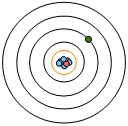The principal quantum number, denoted as n, is a fundamental concept in quantum mechanics that describes the size and energy level of atomic orbitals. As the value of n increases, both the size of the shell and the energy level associated with that shell also increase. This relationship is crucial for understanding the structure of atoms and their arrangement in the periodic table.
Each principal quantum number corresponds to a specific shell, with n values ranging from 1 to 7 currently observed in the periodic table. For instance, n = 1 corresponds to the first shell, which is linked to period 1 of the periodic table, while n = 7 corresponds to the seventh shell, associated with period 7. This connection illustrates how the energy levels of electrons in an atom are organized according to the rows of the periodic table.
It is important to note that the periodic table is not a static entity; it evolves as new elements are discovered or synthesized. Currently, there are seven periods, but advancements in technology and exploration may lead to the identification of new elements, potentially expanding the periodic table to include more than seven rows in the future. Thus, the principal quantum number n can theoretically take on any positive integer value, starting from 1 and extending to infinity. This means that values such as n = 22 are conceivable, even if they have not yet been realized.
In summary, the principal quantum number is integral to understanding the size and energy of atomic orbitals, influencing the arrangement of elements in the periodic table and highlighting the dynamic nature of scientific discovery.



